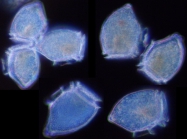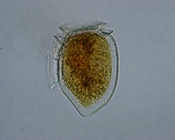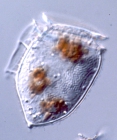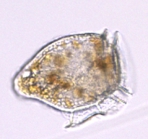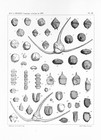WoRMS taxon details
Dinophysis norvegica Claparède & Lachmann, 1859
109637 (urn:lsid:marinespecies.org:taxname:109637)
accepted
Species
Dinophysis debilior Paulsen, 1949 · unaccepted (synonym)
Dinophysis norvegica var. debilior Paulsen, 1907 · unaccepted (synonym)
- Forma Dinophysis norvegica f. crassior (O.W.Paulsen) I.Solum
- Forma Dinophysis norvegica f. debilior (O.W.Paulsen) I.Solum
- Forma Dinophysis norvegica f. rotundata I.Solum
- Variety Dinophysis norvegica var. crassicornis C.E.H.Ostenfeld
- Variety Dinophysis norvegica var. crassior O.W.Paulsen
- Variety Dinophysis norvegica var. debilior Paulsen, 1907 accepted as Dinophysis norvegica Claparède & Lachmann, 1859 (synonym)
marine, fresh, terrestrial
Claparède E. & Lachmann J. (1858). Etudes sur les Infusoires et les Rhizopodes. <em>Mém. Inst. Genev.</em> 5, 6: 489 pp. [details]
Type locality contained in Norwegian Exclusive Economic Zone
type locality contained in Norwegian Exclusive Economic Zone [details]
LSID urn:lsid:algaebase.org:taxname:47033
Description Large, robust cell with fully rounded dorsal curvature and a straightangled lateral profile to the lower half of the...
Distribution Widely distributed in cold to temperate coastal waters of the Northern Hemisphere.
Distribution Cold-temperate water species. Forms very dense blooms in the Baltic Sea associated with the pycnocline (Carpenter et al....
Distribution neritic, cold water species
LSID urn:lsid:algaebase.org:taxname:47033 [details]
Description Large, robust cell with fully rounded dorsal curvature and a straightangled lateral profile to the lower half of the...
Description Large, robust cell with fully rounded dorsal curvature and a straightangled lateral profile to the lower half of the ventral margin. The deepest part of the cell is about midway between the lower cingular list and the antapex, and the R3 of the left sulcal list occurs at this point or just above it. Plate surfaces with large areolae with pores, type E. Posterior and dorsal margins sometimes with protuberances or thick extensions called bosses. [details]
Distribution Widely distributed in cold to temperate coastal waters of the Northern Hemisphere.
Distribution Widely distributed in cold to temperate coastal waters of the Northern Hemisphere. [details]
Distribution Cold-temperate water species. Forms very dense blooms in the Baltic Sea associated with the pycnocline (Carpenter et al....
Distribution Cold-temperate water species. Forms very dense blooms in the Baltic Sea associated with the pycnocline (Carpenter et al. 1995)
Very dense blooms in eastern Canada associated with mild DSP outbreaks (Subba Rao et al. 1993).
[details]
Very dense blooms in eastern Canada associated with mild DSP outbreaks (Subba Rao et al. 1993).
[details]
Distribution neritic, cold water species
Distribution neritic, cold water species [details]
Guiry, M.D. & Guiry, G.M. (2024). AlgaeBase. World-wide electronic publication, National University of Ireland, Galway (taxonomic information republished from AlgaeBase with permission of M.D. Guiry). Dinophysis norvegica Claparède & Lachmann, 1859. Accessed through: World Register of Marine Species at: https://www.marinespecies.org/aphia.php?p=taxdetails&id=109637 on 2024-09-26
Date
action
by
Copyright notice: the information originating from AlgaeBase may not be downloaded or replicated by any means, without the written permission of the copyright owner (generally AlgaeBase). Fair usage of data in scientific publications is permitted.
original description
Claparède E. & Lachmann J. (1858). Etudes sur les Infusoires et les Rhizopodes. <em>Mém. Inst. Genev.</em> 5, 6: 489 pp. [details]
basis of record Gómez, F. (2005). A list of free-living dinoflagellate species in the world's oceans. <em>Acta Bot. Croat.</em> 64(1): 129-212. [details]
additional source Guiry, M.D. & Guiry, G.M. (2024). AlgaeBase. <em>World-wide electronic publication, National University of Ireland, Galway.</em> searched on YYYY-MM-DD., available online at http://www.algaebase.org [details]
additional source Integrated Taxonomic Information System (ITIS). , available online at http://www.itis.gov [details]
additional source Tomas, C.R. (Ed.). (1997). Identifying marine phytoplankton. Academic Press: San Diego, CA [etc.] (USA). ISBN 0-12-693018-X. XV, 858 pp., available online at http://www.sciencedirect.com/science/book/9780126930184 [details]
additional source Brandt, S. (2001). Dinoflagellates, <B><I>in</I></B>: Costello, M.J. <i>et al.</i> (Ed.) (2001). <i>European register of marine species: a check-list of the marine species in Europe and a bibliography of guides to their identification. Collection Patrimoines Naturels,</i> 50: pp. 47-53 (look up in IMIS) [details]
additional source Horner, R. A. (2002). A taxonomic guide to some common marine phytoplankton. <em>Biopress Ltd. Bristol.</em> 1-195. [details]
additional source Martin, J. L.; LeGresley, M. M. ; Strain, P. M. (2001). Phytoplankton monitoring in the Western Isles region of the Bay of Fundy during 1997-98. <em>Canadian Technical Report of Fisheries and Aquatic Sciences 2349.</em> 4: 1-85. [details]
additional source Thomas, M. L. H. (1983). Marine and coastal systems of the Quoddy Region, New Brunswick. <em>Canadian Special Publication of Fisheries and Aquatic Sciences.</em> 64:1-306. [details] Available for editors [request]
[request]
additional source Lee J.S., lgarashi T., Fraga S., Dahl E., Hovgaard P. & Yasumoto T. (1989). Determination of diarrhetic shellfish toxins in various dinoflagellate species. <em>J. Appl. Phycol.</em> 1, 147-152. [details]
additional source Steidinger, K. A., M. A. Faust, and D. U. Hernández-Becerril. 2009. Dinoflagellates (Dinoflagellata) of the Gulf of Mexico, Pp. 131–154 in Felder, D.L. and D.K. Camp (eds.), Gulf of Mexico–Origins, Waters, and Biota. Biodiversity. Texas A&M Press, College [details]
additional source Moestrup, Ø., Akselman, R., Cronberg, G., Elbraechter, M., Fraga, S., Halim, Y., Hansen, G., Hoppenrath, M., Larsen, J., Lundholm, N., Nguyen, L. N., Zingone, A. (Eds) (2009 onwards). IOC-UNESCO Taxonomic Reference List of Harmful Micro Algae., available online at http://www.marinespecies.org/HAB [details]
additional source Meunier, A. (1910). Microplankton des Mers de Barents et de Kara. Duc d'Orléans. Campagne arctique de 1907. Imprimerie scientifique Charles Bulens: Bruxelles, Belgium. 355 + atlas (XXXVII plates) pp. (look up in IMIS) [details]
additional source Steidinger, K.A.; Tangen, K. (1997). Dinoflagellates. pp. 387-584. In: C.R. Tomas (ed.) (1997). Identifying Marine Phytoplankton. Academic Press: San Diego, CA [etc.] (USA). ISBN 0-12-693018-X. XV, 858 pp., available online at http://www.sciencedirect.com/science/article/pii/B9780126930184500057 [details]
additional source Kofoid, C.A.; Skogsberg, T. (1928). Reports on the scientific results of the expedition to the Eastern Tropical Pacific, in charge of Alexander Agassiz, by the U.S. Fish Commission Steamer "Albatross" from October 1904 to March 1905, Lieut. Commander L.M. Garrett, U.S.N., Commanding. [No.] XXXV. The Dinoflagellata: the Dinophysoidae. <em>Memoirs of the Museum of Comparative Zoölogy, at Harvard College, Cambridge, Mass.</em> 51: 1-766., available online at https://www.biodiversitylibrary.org/page/4365822 [details] Available for editors [request]
[request]
ecology source Hansen, P. J.; Tillmann, U. (2020). Mixotrophy in Dinoflagellates: Prey Selection, Physiology and Ecological Importance in Dinoflagellates: Classification, Evolution, Physiology and Ecological Significance. <em>Ed: Subba Rao Durvasula. Publisher: Nova Science Publishers, Inc. New York, USA.</em> [details]
ecology source Mitra, A.; Caron, D. A.; Faure, E.; Flynn, K. J.; Leles, S. G.; Hansen, P. J.; McManus, G. B.; Not, F.; Do Rosario Gomes, H.; Santoferrara, L. F.; Stoecker, D. K.; Tillmann, U. (2023). The Mixoplankton Database (MDB): Diversity of photo‐phago‐trophic plankton in form, function, and distribution across the global ocean. <em>Journal of Eukaryotic Microbiology.</em> 70(4)., available online at https://doi.org/10.1111/jeu.12972 [details]
ecology source Jacobson, D. M.; Andersen, R. A. (1994). The discovery of mixotrophy in photosynthetic species of Dinophysis (Dinophyceae): light and electron microscopical observations of food vacuoles in Dinophysis acuminata, D. norvegica and two heterotrophic dinophysoid dinoflagellates. <em>Phycologia.</em> 33(2): 97-110., available online at https://doi.org/10.2216/i0031-8884-33-2-97.1 [details]
basis of record Gómez, F. (2005). A list of free-living dinoflagellate species in the world's oceans. <em>Acta Bot. Croat.</em> 64(1): 129-212. [details]
additional source Guiry, M.D. & Guiry, G.M. (2024). AlgaeBase. <em>World-wide electronic publication, National University of Ireland, Galway.</em> searched on YYYY-MM-DD., available online at http://www.algaebase.org [details]
additional source Integrated Taxonomic Information System (ITIS). , available online at http://www.itis.gov [details]
additional source Tomas, C.R. (Ed.). (1997). Identifying marine phytoplankton. Academic Press: San Diego, CA [etc.] (USA). ISBN 0-12-693018-X. XV, 858 pp., available online at http://www.sciencedirect.com/science/book/9780126930184 [details]
additional source Brandt, S. (2001). Dinoflagellates, <B><I>in</I></B>: Costello, M.J. <i>et al.</i> (Ed.) (2001). <i>European register of marine species: a check-list of the marine species in Europe and a bibliography of guides to their identification. Collection Patrimoines Naturels,</i> 50: pp. 47-53 (look up in IMIS) [details]
additional source Horner, R. A. (2002). A taxonomic guide to some common marine phytoplankton. <em>Biopress Ltd. Bristol.</em> 1-195. [details]
additional source Martin, J. L.; LeGresley, M. M. ; Strain, P. M. (2001). Phytoplankton monitoring in the Western Isles region of the Bay of Fundy during 1997-98. <em>Canadian Technical Report of Fisheries and Aquatic Sciences 2349.</em> 4: 1-85. [details]
additional source Thomas, M. L. H. (1983). Marine and coastal systems of the Quoddy Region, New Brunswick. <em>Canadian Special Publication of Fisheries and Aquatic Sciences.</em> 64:1-306. [details] Available for editors
additional source Lee J.S., lgarashi T., Fraga S., Dahl E., Hovgaard P. & Yasumoto T. (1989). Determination of diarrhetic shellfish toxins in various dinoflagellate species. <em>J. Appl. Phycol.</em> 1, 147-152. [details]
additional source Steidinger, K. A., M. A. Faust, and D. U. Hernández-Becerril. 2009. Dinoflagellates (Dinoflagellata) of the Gulf of Mexico, Pp. 131–154 in Felder, D.L. and D.K. Camp (eds.), Gulf of Mexico–Origins, Waters, and Biota. Biodiversity. Texas A&M Press, College [details]
additional source Moestrup, Ø., Akselman, R., Cronberg, G., Elbraechter, M., Fraga, S., Halim, Y., Hansen, G., Hoppenrath, M., Larsen, J., Lundholm, N., Nguyen, L. N., Zingone, A. (Eds) (2009 onwards). IOC-UNESCO Taxonomic Reference List of Harmful Micro Algae., available online at http://www.marinespecies.org/HAB [details]
additional source Meunier, A. (1910). Microplankton des Mers de Barents et de Kara. Duc d'Orléans. Campagne arctique de 1907. Imprimerie scientifique Charles Bulens: Bruxelles, Belgium. 355 + atlas (XXXVII plates) pp. (look up in IMIS) [details]
additional source Steidinger, K.A.; Tangen, K. (1997). Dinoflagellates. pp. 387-584. In: C.R. Tomas (ed.) (1997). Identifying Marine Phytoplankton. Academic Press: San Diego, CA [etc.] (USA). ISBN 0-12-693018-X. XV, 858 pp., available online at http://www.sciencedirect.com/science/article/pii/B9780126930184500057 [details]
additional source Kofoid, C.A.; Skogsberg, T. (1928). Reports on the scientific results of the expedition to the Eastern Tropical Pacific, in charge of Alexander Agassiz, by the U.S. Fish Commission Steamer "Albatross" from October 1904 to March 1905, Lieut. Commander L.M. Garrett, U.S.N., Commanding. [No.] XXXV. The Dinoflagellata: the Dinophysoidae. <em>Memoirs of the Museum of Comparative Zoölogy, at Harvard College, Cambridge, Mass.</em> 51: 1-766., available online at https://www.biodiversitylibrary.org/page/4365822 [details] Available for editors
ecology source Hansen, P. J.; Tillmann, U. (2020). Mixotrophy in Dinoflagellates: Prey Selection, Physiology and Ecological Importance in Dinoflagellates: Classification, Evolution, Physiology and Ecological Significance. <em>Ed: Subba Rao Durvasula. Publisher: Nova Science Publishers, Inc. New York, USA.</em> [details]
ecology source Mitra, A.; Caron, D. A.; Faure, E.; Flynn, K. J.; Leles, S. G.; Hansen, P. J.; McManus, G. B.; Not, F.; Do Rosario Gomes, H.; Santoferrara, L. F.; Stoecker, D. K.; Tillmann, U. (2023). The Mixoplankton Database (MDB): Diversity of photo‐phago‐trophic plankton in form, function, and distribution across the global ocean. <em>Journal of Eukaryotic Microbiology.</em> 70(4)., available online at https://doi.org/10.1111/jeu.12972 [details]
ecology source Jacobson, D. M.; Andersen, R. A. (1994). The discovery of mixotrophy in photosynthetic species of Dinophysis (Dinophyceae): light and electron microscopical observations of food vacuoles in Dinophysis acuminata, D. norvegica and two heterotrophic dinophysoid dinoflagellates. <em>Phycologia.</em> 33(2): 97-110., available online at https://doi.org/10.2216/i0031-8884-33-2-97.1 [details]
 Present
Present  Present in aphia/obis/gbif/idigbio
Present in aphia/obis/gbif/idigbio  Inaccurate
Inaccurate  Introduced: alien
Introduced: alien  Containing type locality
Containing type locality
From editor or global species database
LSID urn:lsid:algaebase.org:taxname:47033 [details]From regional or thematic species database
Description Large, robust cell with fully rounded dorsal curvature and a straightangled lateral profile to the lower half of the ventral margin. The deepest part of the cell is about midway between the lower cingular list and the antapex, and the R3 of the left sulcal list occurs at this point or just above it. Plate surfaces with large areolae with pores, type E. Posterior and dorsal margins sometimes with protuberances or thick extensions called bosses. [details]Diet general for group: both heterotrophic (eats other organisms) and autotrophic (photosynthetic) [details]
Distribution Widely distributed in cold to temperate coastal waters of the Northern Hemisphere. [details]
Distribution Cold-temperate water species. Forms very dense blooms in the Baltic Sea associated with the pycnocline (Carpenter et al. 1995)
Very dense blooms in eastern Canada associated with mild DSP outbreaks (Subba Rao et al. 1993).
[details]
Harmful effect HPLC analyses of Norwegian strains in Lee et al. (1989) had OA (0-0.8) and DTX1 (2.5-14 pg/cell), but HPLC analyses of net hauls with dominance of D. norvegica revealed high content of OA (32.6 + 5 pg/cell) (Cembella 1989).
Most recent analyses by LC-MS have shown that Norwegian strains had PTX2 (0.3-2 pg/cell) and PTX12 (0.1-20.4 pg/cell), and in some cases, traces of OA (Miles et al. 2004).
Japanese strains only contained high levels of PTX2 (51-67 pg/cell) (Suzuki et al. 2009).
[details]
Identification D. acuta can be easily confused with D. norvegica. The distinction between the two species can be made by determining whether the deepest portion of the cell is two-thirds the cell length or one-half and determining the length of the left sulcal list in relation to the cell length. [details]
Toxicology Toxic strains known from Europe and North America.
EUROPE
Denmark: (Emsholm et al. 1996)
Norway:(Dahl & Yndestad 1985; Aune et al. 1996, low toxicity)
Sweden: (Edler 2002)
UK: (Bresnan et al. 2002)
AMERICA
Canada: (Subba Rao et al. 1993; Todd et al. 1993)
Mexico: Pacific coast (Hernandez-Becerril 2003, Licea et al. 2003)
USA: (Freudenthal & Jijina 1985) [details]
Unverified
Distribution neritic, cold water species [details]Habitat pelagic [details]
Importance General: known for producing dangerous toxins, particularly when in large numbers, called "red tides" because the cells are so abundant they make water change color. Also they can produce non-fatal or fatal amounts of toxins in predators (particularly shellfish) that may be eaten by humans. [details]
Predators marine microorganisms and animal larvae [details]
Reproduction general for group: both sexual and asexual [details]
| Language | Name | |
|---|---|---|
| Polish | diofryz | [details] |
Published in AlgaeBase 
Published in AlgaeBase (from synonym Dinophysis norvegica var. debilior Paulsen, 1907)
(from synonym Dinophysis norvegica var. debilior Paulsen, 1907)
Published in AlgaeBase (from synonym Dinophysis debilior Paulsen, 1949)
(from synonym Dinophysis debilior Paulsen, 1949)
To Barcode of Life (8 barcodes)
To Biodiversity Heritage Library (1 publication) (from synonym Dinophysis debilior Paulsen, 1949)
To Biodiversity Heritage Library (28 publications)
To Dyntaxa
To European Nucleotide Archive, ENA (Dinophysis norvegica)
To GenBank (49 nucleotides; 14 proteins)
To PESI
To ITIS

Published in AlgaeBase
 (from synonym Dinophysis norvegica var. debilior Paulsen, 1907)
(from synonym Dinophysis norvegica var. debilior Paulsen, 1907)Published in AlgaeBase
 (from synonym Dinophysis debilior Paulsen, 1949)
(from synonym Dinophysis debilior Paulsen, 1949)To Barcode of Life (8 barcodes)
To Biodiversity Heritage Library (1 publication) (from synonym Dinophysis debilior Paulsen, 1949)
To Biodiversity Heritage Library (28 publications)
To Dyntaxa
To European Nucleotide Archive, ENA (Dinophysis norvegica)
To GenBank (49 nucleotides; 14 proteins)
To PESI
To ITIS
